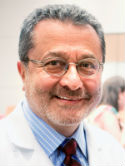Allogeneic hematopoietic stem cell transplantation is underutilized in older patients with myelodysplastic syndromes Journal Article
| Authors: | Getta, B. M.; Kishtagari, A.; Hilden, P.; Tallman, M. S.; Maloy, M.; Gonzales, P.; Castro-Malaspina, H.; Perales, M. A.; Giralt, S.; Tamari, R.; Klimek, V. |
| Article Title: | Allogeneic hematopoietic stem cell transplantation is underutilized in older patients with myelodysplastic syndromes |
| Abstract: | Allogeneic hematopoietic stem cell transplantation (HCT) is the only curative treatment for myelodysplastic syndrome (MDS). The proportion of MDS patients referred for transplantation evaluation, those undergoing transplantation, and the reasons for not undergoing transplantation are unknown. In this retrospective analysis, predefined HCT eligibility and indications criteria were applied to 362 unselected patients with newly diagnosed MDS seen by leukemia faculty between 2008 and 2015 at Memorial Sloan Kettering Cancer Center. Two hundred ninety-four patients (81%) were deemed eligible for transplantation and among these, transplantation was considered indicated in 244 (83%). Of these, 158 of 244 (65%) were referred for transplantation evaluation at a median of 3.9 months from diagnosis. Overall 120 of 362 (33%) underwent transplantation at a median of 7.7 months from diagnosis. Metastatic solid-organ malignancy was the major reason for transplantation ineligibility (54%), and death due to MDS, which occurred in 41% of candidates who did not undergo transplantation, was the major reason for not undergoing transplantation. Factors associated with a lower likelihood of referral for transplantation evaluation included age ≥65 (P <.001), ≥2 comorbidities (P =.008), intermediate-1/low risk MDS (P <.001), <5% blasts at diagnosis (overall P <.001), having Medicare/Medicaid health insurance (P <.001), not being married (P =.017), and diagnosis between 2008 and 2011 (P =.035). On multivariate analysis adjusting for all of the previous factors, diagnosis between 2008 and 2011 (P <.001), age ≥65 (P =.001), and <5% blasts at diagnosis (overall P =.031) were associated with a lower likelihood of referral for transplantation evaluation. Factors associated with a lower likelihood of undergoing transplantation included age ≥65 (P <.001), ≥2 comorbidities (P =.003), intermediate-1/low risk MDS (P <.001), <5% blasts (overall P <.001), very low/low/intermediate risk International Prognostic Scoring System-revised karyotype (P =.018), and having Medicare/Medicaid health insurance (P <.001). In multivariate analysis adjusting for all of the previous factors, age ≥65 (P =.021), presence of ≥2 comorbidities (P =.018), and <5% blasts (overall P =.011) were associated with a lower likelihood of undergoing transplantation. The results highlight that transplantation for MDS remains underutilized, particularly for candidates over the age of 65. © 2017 The American Society for Blood and Marrow Transplantation |
| Keywords: | allogeneic hematopoietic stem cell transplantation; eligibility; barriers; myelodysplasia |
| Journal Title: | Biology of Blood and Marrow Transplantation |
| Volume: | 23 |
| Issue: | 7 |
| ISSN: | 1083-8791 |
| Publisher: | Elsevier Inc. |
| Date Published: | 2017-07-01 |
| Start Page: | 1078 |
| End Page: | 1086 |
| Language: | English |
| DOI: | 10.1016/j.bbmt.2017.03.020 |
| PROVIDER: | scopus |
| PUBMED: | 28336325 |
| PMCID: | PMC7386429 |
| DOI/URL: | |
| Notes: | Article -- Export Date: 3 July 2017 -- Source: Scopus |
Altmetric
Citation Impact
BMJ Impact Analytics
MSK Authors
Related MSK Work











